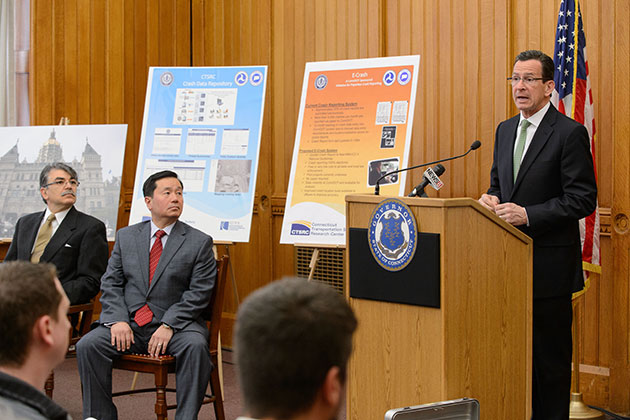
A newly created Connecticut Transportation Safety Research Center at UConn is dramatically improving the collection and processing of car crash data and will serve as an important resource for law enforcement, state residents, policy makers, and others, Gov. Dannel P. Malloy said Monday.
The center, developed in partnership with the Connecticut Department of Transportation (DOT) and other state agencies, is conducting studies and analyses to better understand the causes and contributing factors of car crashes on state roadways.
The data will be readily summarized and available electronically to the public on such issues as distracted driving, bicycle and pedestrian safety, impaired driving, and seat belt use. The information is intended to help cities and towns, as well as regional planning agencies, to address local traffic safety problems.
Connecticut is one of a handful of states that have put in place safety analysis capabilities in partnership with the resources of a major university. The savings achieved in the electronic collection, sharing, and retrieval of this data will result in an improved and more efficiently run highway safety program, as well as increased public awareness through readily available and broadly accessible information.
“The Connecticut Transportation Safety Research Center will distinguish Connecticut as a national leader in transportation safety research and crash data distribution,” Malloy said at an event at the state Capitol recognizing the center’s opening. “This new system means easier and more accurate electronic crash reporting for police using their mobile laptops. Crash scenes will be cleared more quickly for the safety of the officer and the motoring public, without compromising the quality of crash data that needs to be captured.”

The center is building an electronic repository of statewide crash information – previously managed almost exclusively on paper – that provides easy access to an array of crash information, including the number of crashes in a town by location, date, street, injury type, and collision type. The database – under development at www.ctcrash.uconn.edu – allows information to be analyzed to identify hazardous areas, crash patterns, and trends. The new system replaces the old paper-based data entry system, and will save the state money through reduced resources and labor.
On average, 275 people are killed in auto accidents every year in Connecticut. From 2007 to 2010, an average of 289 crashes occurred on public roads in Connecticut each day. And according to the latest data available at the federal Centers for Disease Control and Prevention, in 2005 Connecticut spent more than $260 million in crash-related costs resulting from 262 fatal accidents.
“Highway safety and the public health of our citizens is important to all of us, and the University of Connecticut is proud to partner with the DOT in creating this new research center dedicated to making Connecticut’s roads and highways safe for everyone,” said UConn Provost Mun Choi. “The Connecticut Transportation Safety Research Center will provide an important service to the people of Connecticut, and UConn is proud to part of that effort.”
The new data collection system will also provide for linkage to other criminal justice databases to support prosecution of traffic violations, and to public health databases to measure the medical outcomes and costs of injuries.
“This repository was developed by UConn engineering graduate students and it is the envy of other states, which have contacted Connecticut to learn how our system was built,” said Kazem Kazerounian, interim dean of UConn’s School of Engineering. “Our system is a model that other states seek to replicate.”
The center’s crash data repository was recently nominated for the “White House Champions of Change: Transportation Technology Solutions for the 21st Century” honor, Kazerounian said.
The center, which began operations in the Longley Building on UConn’s Depot Campus last fall, is made possible through a Memorandum of Understanding between the Connecticut Transportation Institute at UConn and the Connecticut DOT, which has committed $600,000 in federal funds to support the center’s first year.
More than 5,000 paper crash reports are filed with the DOT each month; this reliance on paper reports has resulted in an extensive backlog in crash data collection, limiting the ability of the DOT and its partners to have access to timely, accurate, and complete crash data.

“The center at UConn will assist us in creating an ‘E-Crash’ data collection system that will dramatically improve the way information for the state’s automotive crash database is collected and processed,” DOT Commissioner James P. Redeker said. “The ‘E-Crash’ system will allow for 100 percent electronic filing of state crash reports.”
The new “E-Crash” data collection system will provide state and local police agencies a range of options to use in the submission of electronic crash data. Pilot systems are under development with the state police and the Capital Regional Council of Governments (CRCOG). The goal is to provide data collection software at little or no cost to police departments, while conforming to a statewide standard for crash data entry, submission, and transfer.
The center has already been successful in supporting community-based access to important safety data. CRCOG has quickly found the repository to be useful in supporting regional transportation analyses; Yale New Haven Hospital’s community-based coalition is now mapping impaired driving crashes in South Central Connecticut; personnel from the new center recently participated in a major impaired driving conference that featured research presentations by national experts.
The Connecticut Transportation Safety Research Center shares space with the Connecticut Transportation Institute (CTI) at the Longley Building in Storrs. Eric Jackson, an assistant research professor with CTI, serves as the CTSRC’s director.
The center complements UConn’s existing strengths in transportation research and will build upon the work already being done at the University at the Connecticut Transportation Institute, the Technology Transfer Center, and the Center for Transportation and Livable Systems.



